Methodology for Nutritional Analysis Data Mining Project Report
VerifiedAdded on 2022/12/28
|10
|2643
|42
Report
AI Summary
This report outlines the methodology employed for a data mining project focused on nutritional analysis of people's daily routines. It details the application of the Knowledge Discovery in Databases (KDD) framework, encompassing data selection, cleaning, transformation, and mining stages. The data mining goal is identified as extracting useful information through classification techniques, particularly relevant to understanding the relationship between lifestyle and health. The data collection process involves both primary and secondary sources, including face-to-face interviews and online articles. The report also specifies the use of various data mining approaches and algorithms, such as feature evaluation and selection (mutual information, Chi-squared), Support Vector Machines, Bayesian Networks, Neural Networks, Ensemble methods (Random Forest), and Association rules. Descriptive and predictive statistical analyses, including empirical evaluations, are proposed to validate research objectives and predict future outcomes related to lifestyle and disease.

Methodology
Paraphrase This Document
Need a fresh take? Get an instant paraphrase of this document with our AI Paraphraser
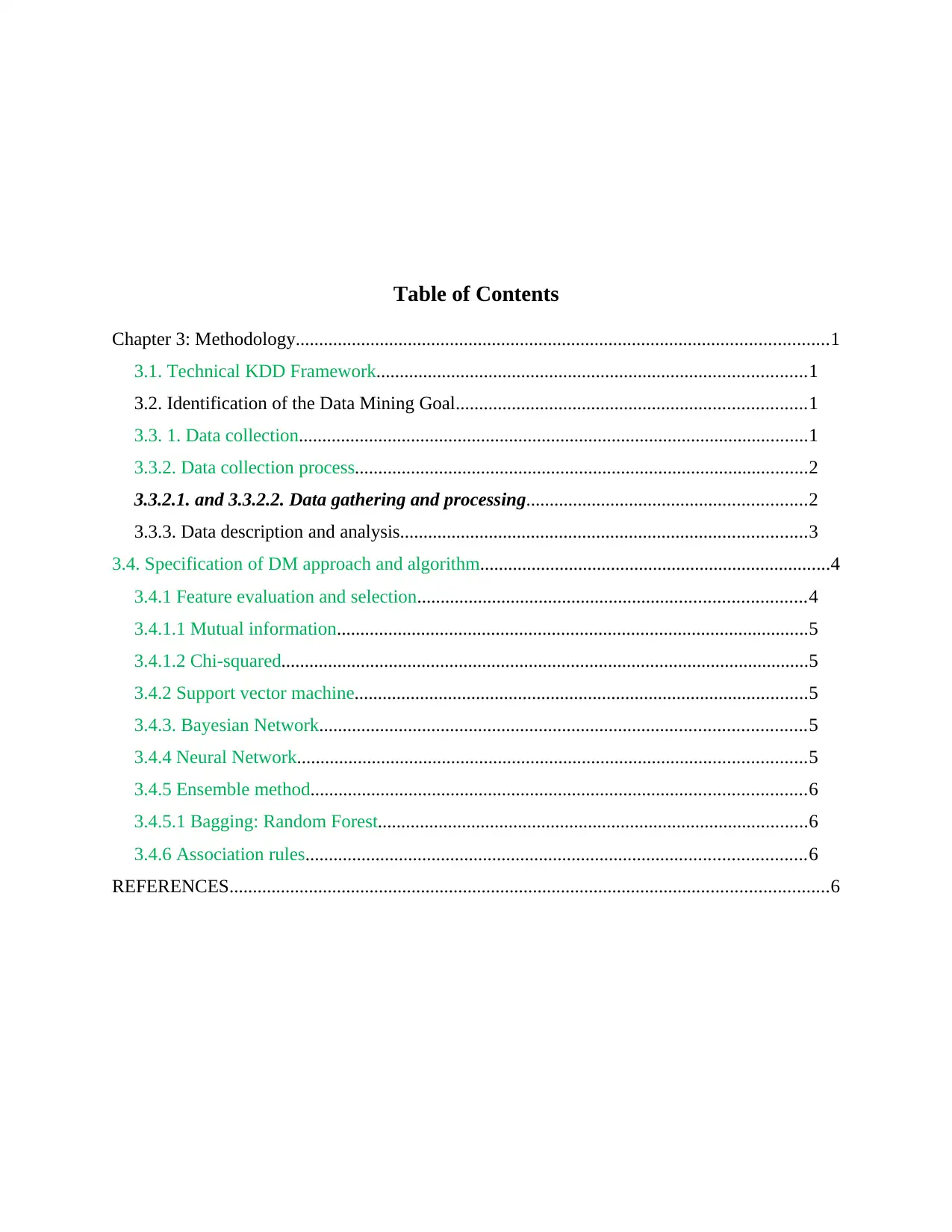
Table of Contents
Chapter 3: Methodology..................................................................................................................1
3.1. Technical KDD Framework............................................................................................1
3.2. Identification of the Data Mining Goal...........................................................................1
3.3. 1. Data collection.............................................................................................................1
3.3.2. Data collection process.................................................................................................2
3.3.2.1. and 3.3.2.2. Data gathering and processing............................................................2
3.3.3. Data description and analysis.......................................................................................3
3.4. Specification of DM approach and algorithm...........................................................................4
3.4.1 Feature evaluation and selection...................................................................................4
3.4.1.1 Mutual information.....................................................................................................5
3.4.1.2 Chi-squared.................................................................................................................5
3.4.2 Support vector machine.................................................................................................5
3.4.3. Bayesian Network........................................................................................................5
3.4.4 Neural Network.............................................................................................................5
3.4.5 Ensemble method..........................................................................................................6
3.4.5.1 Bagging: Random Forest............................................................................................6
3.4.6 Association rules...........................................................................................................6
REFERENCES................................................................................................................................6
Chapter 3: Methodology..................................................................................................................1
3.1. Technical KDD Framework............................................................................................1
3.2. Identification of the Data Mining Goal...........................................................................1
3.3. 1. Data collection.............................................................................................................1
3.3.2. Data collection process.................................................................................................2
3.3.2.1. and 3.3.2.2. Data gathering and processing............................................................2
3.3.3. Data description and analysis.......................................................................................3
3.4. Specification of DM approach and algorithm...........................................................................4
3.4.1 Feature evaluation and selection...................................................................................4
3.4.1.1 Mutual information.....................................................................................................5
3.4.1.2 Chi-squared.................................................................................................................5
3.4.2 Support vector machine.................................................................................................5
3.4.3. Bayesian Network........................................................................................................5
3.4.4 Neural Network.............................................................................................................5
3.4.5 Ensemble method..........................................................................................................6
3.4.5.1 Bagging: Random Forest............................................................................................6
3.4.6 Association rules...........................................................................................................6
REFERENCES................................................................................................................................6

⊘ This is a preview!⊘
Do you want full access?
Subscribe today to unlock all pages.

Trusted by 1+ million students worldwide
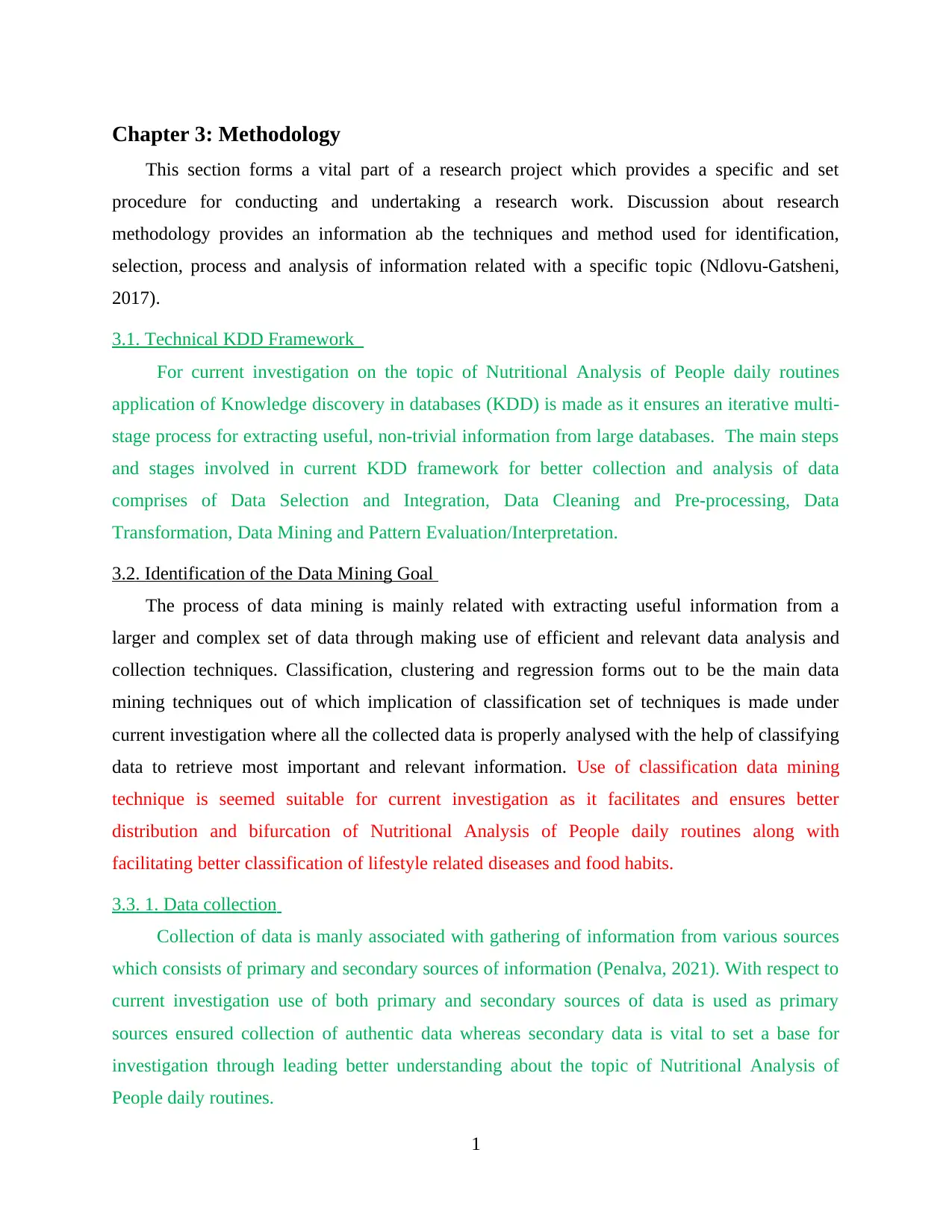
Chapter 3: Methodology
This section forms a vital part of a research project which provides a specific and set
procedure for conducting and undertaking a research work. Discussion about research
methodology provides an information ab the techniques and method used for identification,
selection, process and analysis of information related with a specific topic (Ndlovu-Gatsheni,
2017).
3.1. Technical KDD Framework
For current investigation on the topic of Nutritional Analysis of People daily routines
application of Knowledge discovery in databases (KDD) is made as it ensures an iterative multi-
stage process for extracting useful, non-trivial information from large databases. The main steps
and stages involved in current KDD framework for better collection and analysis of data
comprises of Data Selection and Integration, Data Cleaning and Pre-processing, Data
Transformation, Data Mining and Pattern Evaluation/Interpretation.
3.2. Identification of the Data Mining Goal
The process of data mining is mainly related with extracting useful information from a
larger and complex set of data through making use of efficient and relevant data analysis and
collection techniques. Classification, clustering and regression forms out to be the main data
mining techniques out of which implication of classification set of techniques is made under
current investigation where all the collected data is properly analysed with the help of classifying
data to retrieve most important and relevant information. Use of classification data mining
technique is seemed suitable for current investigation as it facilitates and ensures better
distribution and bifurcation of Nutritional Analysis of People daily routines along with
facilitating better classification of lifestyle related diseases and food habits.
3.3. 1. Data collection
Collection of data is manly associated with gathering of information from various sources
which consists of primary and secondary sources of information (Penalva, 2021). With respect to
current investigation use of both primary and secondary sources of data is used as primary
sources ensured collection of authentic data whereas secondary data is vital to set a base for
investigation through leading better understanding about the topic of Nutritional Analysis of
People daily routines.
1
This section forms a vital part of a research project which provides a specific and set
procedure for conducting and undertaking a research work. Discussion about research
methodology provides an information ab the techniques and method used for identification,
selection, process and analysis of information related with a specific topic (Ndlovu-Gatsheni,
2017).
3.1. Technical KDD Framework
For current investigation on the topic of Nutritional Analysis of People daily routines
application of Knowledge discovery in databases (KDD) is made as it ensures an iterative multi-
stage process for extracting useful, non-trivial information from large databases. The main steps
and stages involved in current KDD framework for better collection and analysis of data
comprises of Data Selection and Integration, Data Cleaning and Pre-processing, Data
Transformation, Data Mining and Pattern Evaluation/Interpretation.
3.2. Identification of the Data Mining Goal
The process of data mining is mainly related with extracting useful information from a
larger and complex set of data through making use of efficient and relevant data analysis and
collection techniques. Classification, clustering and regression forms out to be the main data
mining techniques out of which implication of classification set of techniques is made under
current investigation where all the collected data is properly analysed with the help of classifying
data to retrieve most important and relevant information. Use of classification data mining
technique is seemed suitable for current investigation as it facilitates and ensures better
distribution and bifurcation of Nutritional Analysis of People daily routines along with
facilitating better classification of lifestyle related diseases and food habits.
3.3. 1. Data collection
Collection of data is manly associated with gathering of information from various sources
which consists of primary and secondary sources of information (Penalva, 2021). With respect to
current investigation use of both primary and secondary sources of data is used as primary
sources ensured collection of authentic data whereas secondary data is vital to set a base for
investigation through leading better understanding about the topic of Nutritional Analysis of
People daily routines.
1
Paraphrase This Document
Need a fresh take? Get an instant paraphrase of this document with our AI Paraphraser
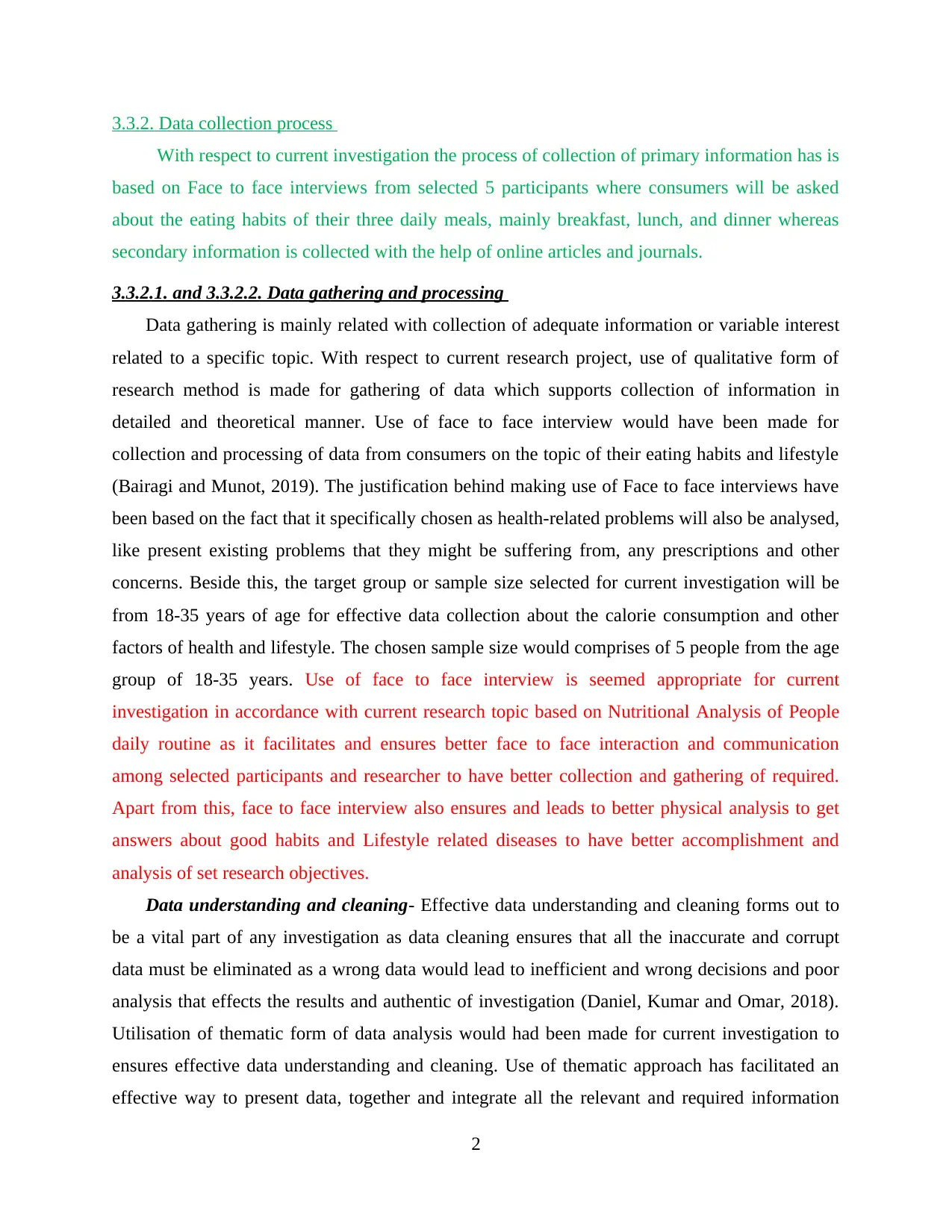
3.3.2. Data collection process
With respect to current investigation the process of collection of primary information has is
based on Face to face interviews from selected 5 participants where consumers will be asked
about the eating habits of their three daily meals, mainly breakfast, lunch, and dinner whereas
secondary information is collected with the help of online articles and journals.
3.3.2.1. and 3.3.2.2. Data gathering and processing
Data gathering is mainly related with collection of adequate information or variable interest
related to a specific topic. With respect to current research project, use of qualitative form of
research method is made for gathering of data which supports collection of information in
detailed and theoretical manner. Use of face to face interview would have been made for
collection and processing of data from consumers on the topic of their eating habits and lifestyle
(Bairagi and Munot, 2019). The justification behind making use of Face to face interviews have
been based on the fact that it specifically chosen as health-related problems will also be analysed,
like present existing problems that they might be suffering from, any prescriptions and other
concerns. Beside this, the target group or sample size selected for current investigation will be
from 18-35 years of age for effective data collection about the calorie consumption and other
factors of health and lifestyle. The chosen sample size would comprises of 5 people from the age
group of 18-35 years. Use of face to face interview is seemed appropriate for current
investigation in accordance with current research topic based on Nutritional Analysis of People
daily routine as it facilitates and ensures better face to face interaction and communication
among selected participants and researcher to have better collection and gathering of required.
Apart from this, face to face interview also ensures and leads to better physical analysis to get
answers about good habits and Lifestyle related diseases to have better accomplishment and
analysis of set research objectives.
Data understanding and cleaning- Effective data understanding and cleaning forms out to
be a vital part of any investigation as data cleaning ensures that all the inaccurate and corrupt
data must be eliminated as a wrong data would lead to inefficient and wrong decisions and poor
analysis that effects the results and authentic of investigation (Daniel, Kumar and Omar, 2018).
Utilisation of thematic form of data analysis would had been made for current investigation to
ensures effective data understanding and cleaning. Use of thematic approach has facilitated an
effective way to present data, together and integrate all the relevant and required information
2
With respect to current investigation the process of collection of primary information has is
based on Face to face interviews from selected 5 participants where consumers will be asked
about the eating habits of their three daily meals, mainly breakfast, lunch, and dinner whereas
secondary information is collected with the help of online articles and journals.
3.3.2.1. and 3.3.2.2. Data gathering and processing
Data gathering is mainly related with collection of adequate information or variable interest
related to a specific topic. With respect to current research project, use of qualitative form of
research method is made for gathering of data which supports collection of information in
detailed and theoretical manner. Use of face to face interview would have been made for
collection and processing of data from consumers on the topic of their eating habits and lifestyle
(Bairagi and Munot, 2019). The justification behind making use of Face to face interviews have
been based on the fact that it specifically chosen as health-related problems will also be analysed,
like present existing problems that they might be suffering from, any prescriptions and other
concerns. Beside this, the target group or sample size selected for current investigation will be
from 18-35 years of age for effective data collection about the calorie consumption and other
factors of health and lifestyle. The chosen sample size would comprises of 5 people from the age
group of 18-35 years. Use of face to face interview is seemed appropriate for current
investigation in accordance with current research topic based on Nutritional Analysis of People
daily routine as it facilitates and ensures better face to face interaction and communication
among selected participants and researcher to have better collection and gathering of required.
Apart from this, face to face interview also ensures and leads to better physical analysis to get
answers about good habits and Lifestyle related diseases to have better accomplishment and
analysis of set research objectives.
Data understanding and cleaning- Effective data understanding and cleaning forms out to
be a vital part of any investigation as data cleaning ensures that all the inaccurate and corrupt
data must be eliminated as a wrong data would lead to inefficient and wrong decisions and poor
analysis that effects the results and authentic of investigation (Daniel, Kumar and Omar, 2018).
Utilisation of thematic form of data analysis would had been made for current investigation to
ensures effective data understanding and cleaning. Use of thematic approach has facilitated an
effective way to present data, together and integrate all the relevant and required information
2
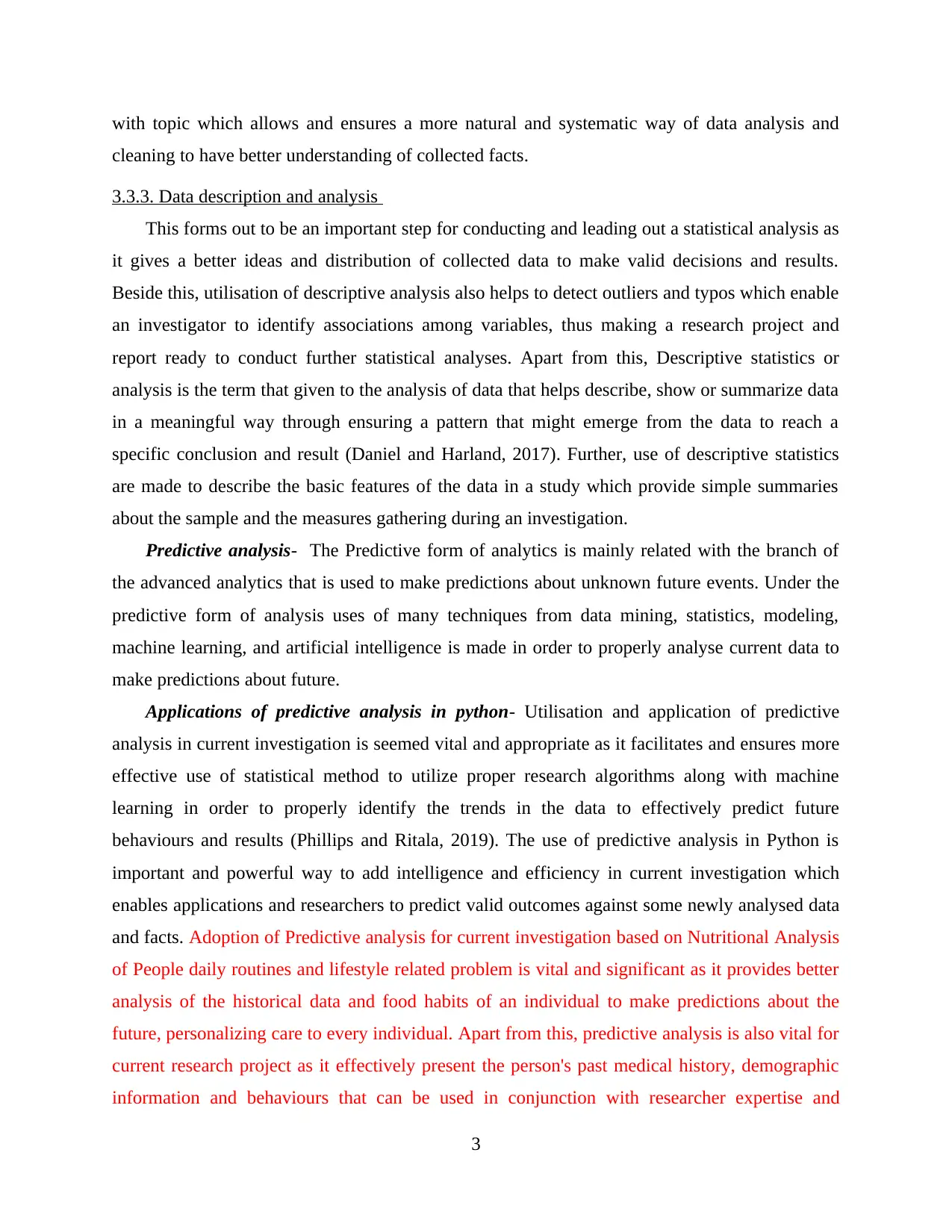
with topic which allows and ensures a more natural and systematic way of data analysis and
cleaning to have better understanding of collected facts.
3.3.3. Data description and analysis
This forms out to be an important step for conducting and leading out a statistical analysis as
it gives a better ideas and distribution of collected data to make valid decisions and results.
Beside this, utilisation of descriptive analysis also helps to detect outliers and typos which enable
an investigator to identify associations among variables, thus making a research project and
report ready to conduct further statistical analyses. Apart from this, Descriptive statistics or
analysis is the term that given to the analysis of data that helps describe, show or summarize data
in a meaningful way through ensuring a pattern that might emerge from the data to reach a
specific conclusion and result (Daniel and Harland, 2017). Further, use of descriptive statistics
are made to describe the basic features of the data in a study which provide simple summaries
about the sample and the measures gathering during an investigation.
Predictive analysis- The Predictive form of analytics is mainly related with the branch of
the advanced analytics that is used to make predictions about unknown future events. Under the
predictive form of analysis uses of many techniques from data mining, statistics, modeling,
machine learning, and artificial intelligence is made in order to properly analyse current data to
make predictions about future.
Applications of predictive analysis in python- Utilisation and application of predictive
analysis in current investigation is seemed vital and appropriate as it facilitates and ensures more
effective use of statistical method to utilize proper research algorithms along with machine
learning in order to properly identify the trends in the data to effectively predict future
behaviours and results (Phillips and Ritala, 2019). The use of predictive analysis in Python is
important and powerful way to add intelligence and efficiency in current investigation which
enables applications and researchers to predict valid outcomes against some newly analysed data
and facts. Adoption of Predictive analysis for current investigation based on Nutritional Analysis
of People daily routines and lifestyle related problem is vital and significant as it provides better
analysis of the historical data and food habits of an individual to make predictions about the
future, personalizing care to every individual. Apart from this, predictive analysis is also vital for
current research project as it effectively present the person's past medical history, demographic
information and behaviours that can be used in conjunction with researcher expertise and
3
cleaning to have better understanding of collected facts.
3.3.3. Data description and analysis
This forms out to be an important step for conducting and leading out a statistical analysis as
it gives a better ideas and distribution of collected data to make valid decisions and results.
Beside this, utilisation of descriptive analysis also helps to detect outliers and typos which enable
an investigator to identify associations among variables, thus making a research project and
report ready to conduct further statistical analyses. Apart from this, Descriptive statistics or
analysis is the term that given to the analysis of data that helps describe, show or summarize data
in a meaningful way through ensuring a pattern that might emerge from the data to reach a
specific conclusion and result (Daniel and Harland, 2017). Further, use of descriptive statistics
are made to describe the basic features of the data in a study which provide simple summaries
about the sample and the measures gathering during an investigation.
Predictive analysis- The Predictive form of analytics is mainly related with the branch of
the advanced analytics that is used to make predictions about unknown future events. Under the
predictive form of analysis uses of many techniques from data mining, statistics, modeling,
machine learning, and artificial intelligence is made in order to properly analyse current data to
make predictions about future.
Applications of predictive analysis in python- Utilisation and application of predictive
analysis in current investigation is seemed vital and appropriate as it facilitates and ensures more
effective use of statistical method to utilize proper research algorithms along with machine
learning in order to properly identify the trends in the data to effectively predict future
behaviours and results (Phillips and Ritala, 2019). The use of predictive analysis in Python is
important and powerful way to add intelligence and efficiency in current investigation which
enables applications and researchers to predict valid outcomes against some newly analysed data
and facts. Adoption of Predictive analysis for current investigation based on Nutritional Analysis
of People daily routines and lifestyle related problem is vital and significant as it provides better
analysis of the historical data and food habits of an individual to make predictions about the
future, personalizing care to every individual. Apart from this, predictive analysis is also vital for
current research project as it effectively present the person's past medical history, demographic
information and behaviours that can be used in conjunction with researcher expertise and
3
⊘ This is a preview!⊘
Do you want full access?
Subscribe today to unlock all pages.

Trusted by 1+ million students worldwide
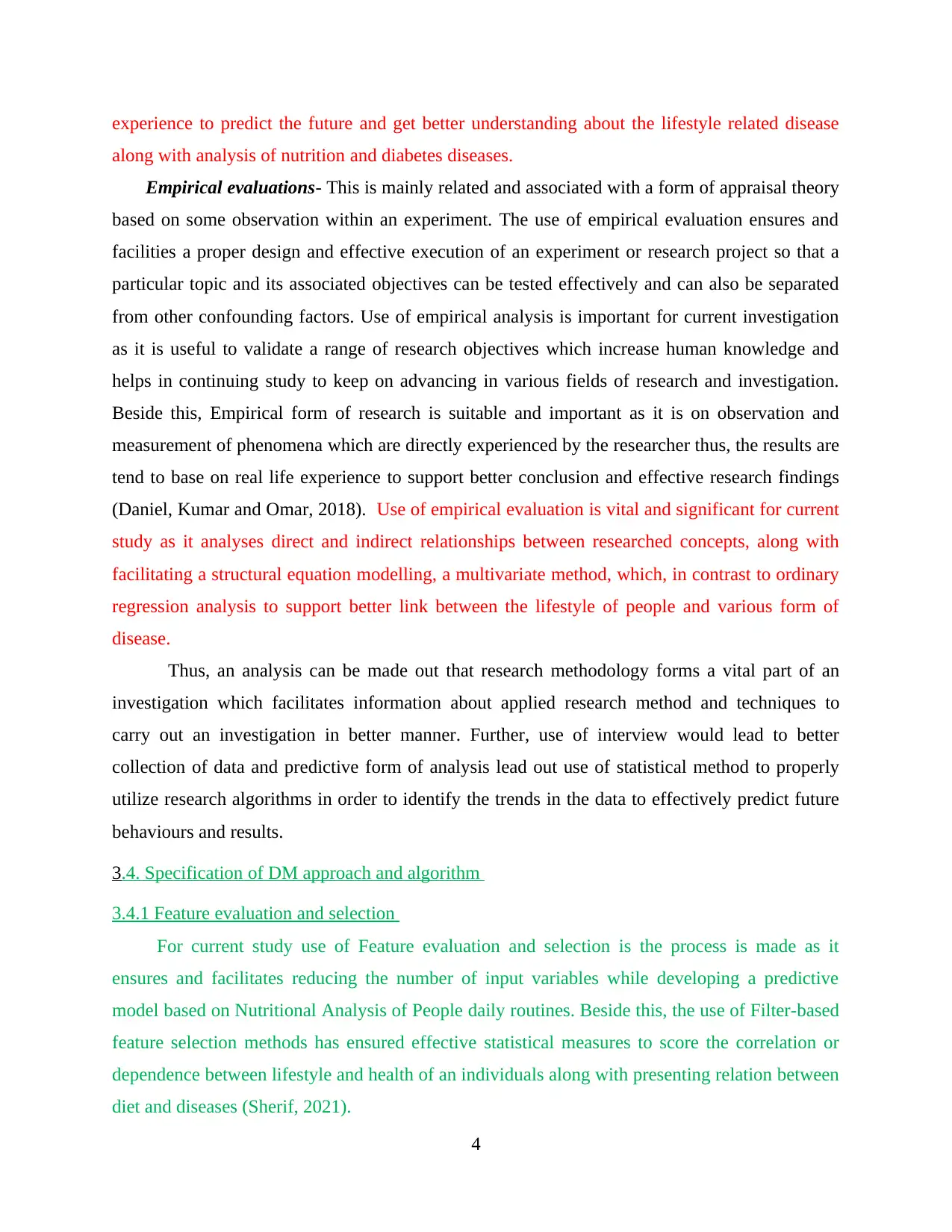
experience to predict the future and get better understanding about the lifestyle related disease
along with analysis of nutrition and diabetes diseases.
Empirical evaluations- This is mainly related and associated with a form of appraisal theory
based on some observation within an experiment. The use of empirical evaluation ensures and
facilities a proper design and effective execution of an experiment or research project so that a
particular topic and its associated objectives can be tested effectively and can also be separated
from other confounding factors. Use of empirical analysis is important for current investigation
as it is useful to validate a range of research objectives which increase human knowledge and
helps in continuing study to keep on advancing in various fields of research and investigation.
Beside this, Empirical form of research is suitable and important as it is on observation and
measurement of phenomena which are directly experienced by the researcher thus, the results are
tend to base on real life experience to support better conclusion and effective research findings
(Daniel, Kumar and Omar, 2018). Use of empirical evaluation is vital and significant for current
study as it analyses direct and indirect relationships between researched concepts, along with
facilitating a structural equation modelling, a multivariate method, which, in contrast to ordinary
regression analysis to support better link between the lifestyle of people and various form of
disease.
Thus, an analysis can be made out that research methodology forms a vital part of an
investigation which facilitates information about applied research method and techniques to
carry out an investigation in better manner. Further, use of interview would lead to better
collection of data and predictive form of analysis lead out use of statistical method to properly
utilize research algorithms in order to identify the trends in the data to effectively predict future
behaviours and results.
3.4. Specification of DM approach and algorithm
3.4.1 Feature evaluation and selection
For current study use of Feature evaluation and selection is the process is made as it
ensures and facilitates reducing the number of input variables while developing a predictive
model based on Nutritional Analysis of People daily routines. Beside this, the use of Filter-based
feature selection methods has ensured effective statistical measures to score the correlation or
dependence between lifestyle and health of an individuals along with presenting relation between
diet and diseases (Sherif, 2021).
4
along with analysis of nutrition and diabetes diseases.
Empirical evaluations- This is mainly related and associated with a form of appraisal theory
based on some observation within an experiment. The use of empirical evaluation ensures and
facilities a proper design and effective execution of an experiment or research project so that a
particular topic and its associated objectives can be tested effectively and can also be separated
from other confounding factors. Use of empirical analysis is important for current investigation
as it is useful to validate a range of research objectives which increase human knowledge and
helps in continuing study to keep on advancing in various fields of research and investigation.
Beside this, Empirical form of research is suitable and important as it is on observation and
measurement of phenomena which are directly experienced by the researcher thus, the results are
tend to base on real life experience to support better conclusion and effective research findings
(Daniel, Kumar and Omar, 2018). Use of empirical evaluation is vital and significant for current
study as it analyses direct and indirect relationships between researched concepts, along with
facilitating a structural equation modelling, a multivariate method, which, in contrast to ordinary
regression analysis to support better link between the lifestyle of people and various form of
disease.
Thus, an analysis can be made out that research methodology forms a vital part of an
investigation which facilitates information about applied research method and techniques to
carry out an investigation in better manner. Further, use of interview would lead to better
collection of data and predictive form of analysis lead out use of statistical method to properly
utilize research algorithms in order to identify the trends in the data to effectively predict future
behaviours and results.
3.4. Specification of DM approach and algorithm
3.4.1 Feature evaluation and selection
For current study use of Feature evaluation and selection is the process is made as it
ensures and facilitates reducing the number of input variables while developing a predictive
model based on Nutritional Analysis of People daily routines. Beside this, the use of Filter-based
feature selection methods has ensured effective statistical measures to score the correlation or
dependence between lifestyle and health of an individuals along with presenting relation between
diet and diseases (Sherif, 2021).
4
Paraphrase This Document
Need a fresh take? Get an instant paraphrase of this document with our AI Paraphraser
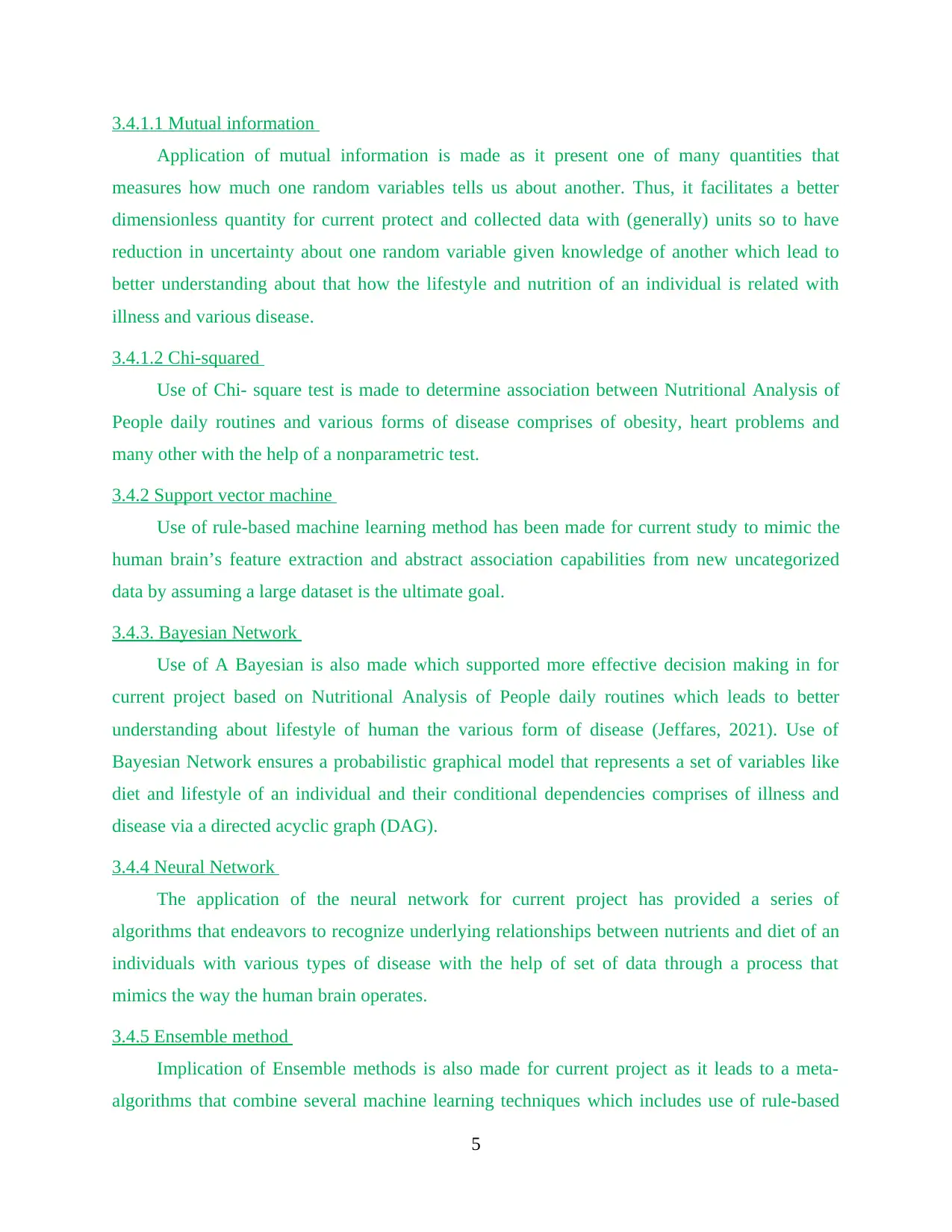
3.4.1.1 Mutual information
Application of mutual information is made as it present one of many quantities that
measures how much one random variables tells us about another. Thus, it facilitates a better
dimensionless quantity for current protect and collected data with (generally) units so to have
reduction in uncertainty about one random variable given knowledge of another which lead to
better understanding about that how the lifestyle and nutrition of an individual is related with
illness and various disease.
3.4.1.2 Chi-squared
Use of Chi- square test is made to determine association between Nutritional Analysis of
People daily routines and various forms of disease comprises of obesity, heart problems and
many other with the help of a nonparametric test.
3.4.2 Support vector machine
Use of rule-based machine learning method has been made for current study to mimic the
human brain’s feature extraction and abstract association capabilities from new uncategorized
data by assuming a large dataset is the ultimate goal.
3.4.3. Bayesian Network
Use of A Bayesian is also made which supported more effective decision making in for
current project based on Nutritional Analysis of People daily routines which leads to better
understanding about lifestyle of human the various form of disease (Jeffares, 2021). Use of
Bayesian Network ensures a probabilistic graphical model that represents a set of variables like
diet and lifestyle of an individual and their conditional dependencies comprises of illness and
disease via a directed acyclic graph (DAG).
3.4.4 Neural Network
The application of the neural network for current project has provided a series of
algorithms that endeavors to recognize underlying relationships between nutrients and diet of an
individuals with various types of disease with the help of set of data through a process that
mimics the way the human brain operates.
3.4.5 Ensemble method
Implication of Ensemble methods is also made for current project as it leads to a meta-
algorithms that combine several machine learning techniques which includes use of rule-based
5
Application of mutual information is made as it present one of many quantities that
measures how much one random variables tells us about another. Thus, it facilitates a better
dimensionless quantity for current protect and collected data with (generally) units so to have
reduction in uncertainty about one random variable given knowledge of another which lead to
better understanding about that how the lifestyle and nutrition of an individual is related with
illness and various disease.
3.4.1.2 Chi-squared
Use of Chi- square test is made to determine association between Nutritional Analysis of
People daily routines and various forms of disease comprises of obesity, heart problems and
many other with the help of a nonparametric test.
3.4.2 Support vector machine
Use of rule-based machine learning method has been made for current study to mimic the
human brain’s feature extraction and abstract association capabilities from new uncategorized
data by assuming a large dataset is the ultimate goal.
3.4.3. Bayesian Network
Use of A Bayesian is also made which supported more effective decision making in for
current project based on Nutritional Analysis of People daily routines which leads to better
understanding about lifestyle of human the various form of disease (Jeffares, 2021). Use of
Bayesian Network ensures a probabilistic graphical model that represents a set of variables like
diet and lifestyle of an individual and their conditional dependencies comprises of illness and
disease via a directed acyclic graph (DAG).
3.4.4 Neural Network
The application of the neural network for current project has provided a series of
algorithms that endeavors to recognize underlying relationships between nutrients and diet of an
individuals with various types of disease with the help of set of data through a process that
mimics the way the human brain operates.
3.4.5 Ensemble method
Implication of Ensemble methods is also made for current project as it leads to a meta-
algorithms that combine several machine learning techniques which includes use of rule-based
5
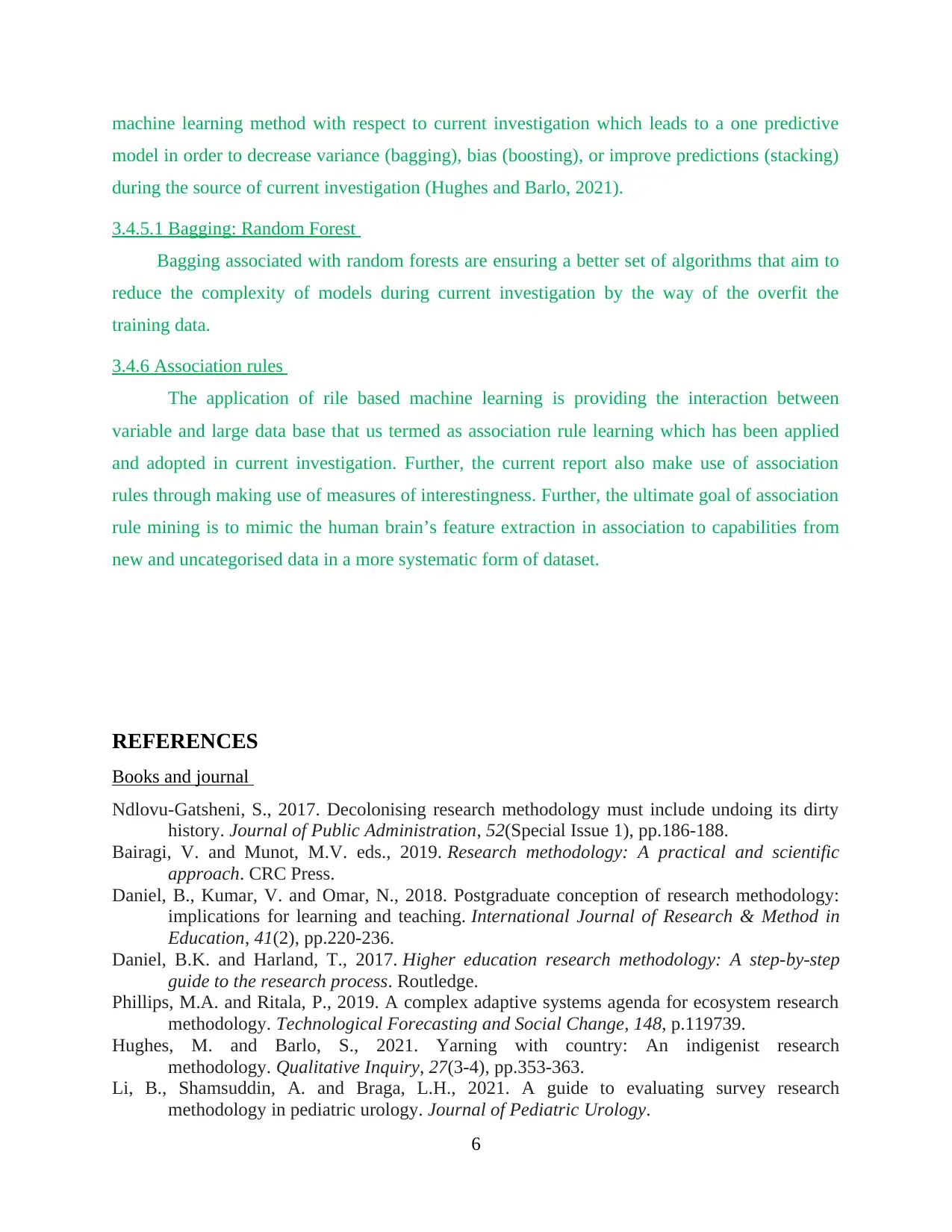
machine learning method with respect to current investigation which leads to a one predictive
model in order to decrease variance (bagging), bias (boosting), or improve predictions (stacking)
during the source of current investigation (Hughes and Barlo, 2021).
3.4.5.1 Bagging: Random Forest
Bagging associated with random forests are ensuring a better set of algorithms that aim to
reduce the complexity of models during current investigation by the way of the overfit the
training data.
3.4.6 Association rules
The application of rile based machine learning is providing the interaction between
variable and large data base that us termed as association rule learning which has been applied
and adopted in current investigation. Further, the current report also make use of association
rules through making use of measures of interestingness. Further, the ultimate goal of association
rule mining is to mimic the human brain’s feature extraction in association to capabilities from
new and uncategorised data in a more systematic form of dataset.
REFERENCES
Books and journal
Ndlovu-Gatsheni, S., 2017. Decolonising research methodology must include undoing its dirty
history. Journal of Public Administration, 52(Special Issue 1), pp.186-188.
Bairagi, V. and Munot, M.V. eds., 2019. Research methodology: A practical and scientific
approach. CRC Press.
Daniel, B., Kumar, V. and Omar, N., 2018. Postgraduate conception of research methodology:
implications for learning and teaching. International Journal of Research & Method in
Education, 41(2), pp.220-236.
Daniel, B.K. and Harland, T., 2017. Higher education research methodology: A step-by-step
guide to the research process. Routledge.
Phillips, M.A. and Ritala, P., 2019. A complex adaptive systems agenda for ecosystem research
methodology. Technological Forecasting and Social Change, 148, p.119739.
Hughes, M. and Barlo, S., 2021. Yarning with country: An indigenist research
methodology. Qualitative Inquiry, 27(3-4), pp.353-363.
Li, B., Shamsuddin, A. and Braga, L.H., 2021. A guide to evaluating survey research
methodology in pediatric urology. Journal of Pediatric Urology.
6
model in order to decrease variance (bagging), bias (boosting), or improve predictions (stacking)
during the source of current investigation (Hughes and Barlo, 2021).
3.4.5.1 Bagging: Random Forest
Bagging associated with random forests are ensuring a better set of algorithms that aim to
reduce the complexity of models during current investigation by the way of the overfit the
training data.
3.4.6 Association rules
The application of rile based machine learning is providing the interaction between
variable and large data base that us termed as association rule learning which has been applied
and adopted in current investigation. Further, the current report also make use of association
rules through making use of measures of interestingness. Further, the ultimate goal of association
rule mining is to mimic the human brain’s feature extraction in association to capabilities from
new and uncategorised data in a more systematic form of dataset.
REFERENCES
Books and journal
Ndlovu-Gatsheni, S., 2017. Decolonising research methodology must include undoing its dirty
history. Journal of Public Administration, 52(Special Issue 1), pp.186-188.
Bairagi, V. and Munot, M.V. eds., 2019. Research methodology: A practical and scientific
approach. CRC Press.
Daniel, B., Kumar, V. and Omar, N., 2018. Postgraduate conception of research methodology:
implications for learning and teaching. International Journal of Research & Method in
Education, 41(2), pp.220-236.
Daniel, B.K. and Harland, T., 2017. Higher education research methodology: A step-by-step
guide to the research process. Routledge.
Phillips, M.A. and Ritala, P., 2019. A complex adaptive systems agenda for ecosystem research
methodology. Technological Forecasting and Social Change, 148, p.119739.
Hughes, M. and Barlo, S., 2021. Yarning with country: An indigenist research
methodology. Qualitative Inquiry, 27(3-4), pp.353-363.
Li, B., Shamsuddin, A. and Braga, L.H., 2021. A guide to evaluating survey research
methodology in pediatric urology. Journal of Pediatric Urology.
6
⊘ This is a preview!⊘
Do you want full access?
Subscribe today to unlock all pages.

Trusted by 1+ million students worldwide
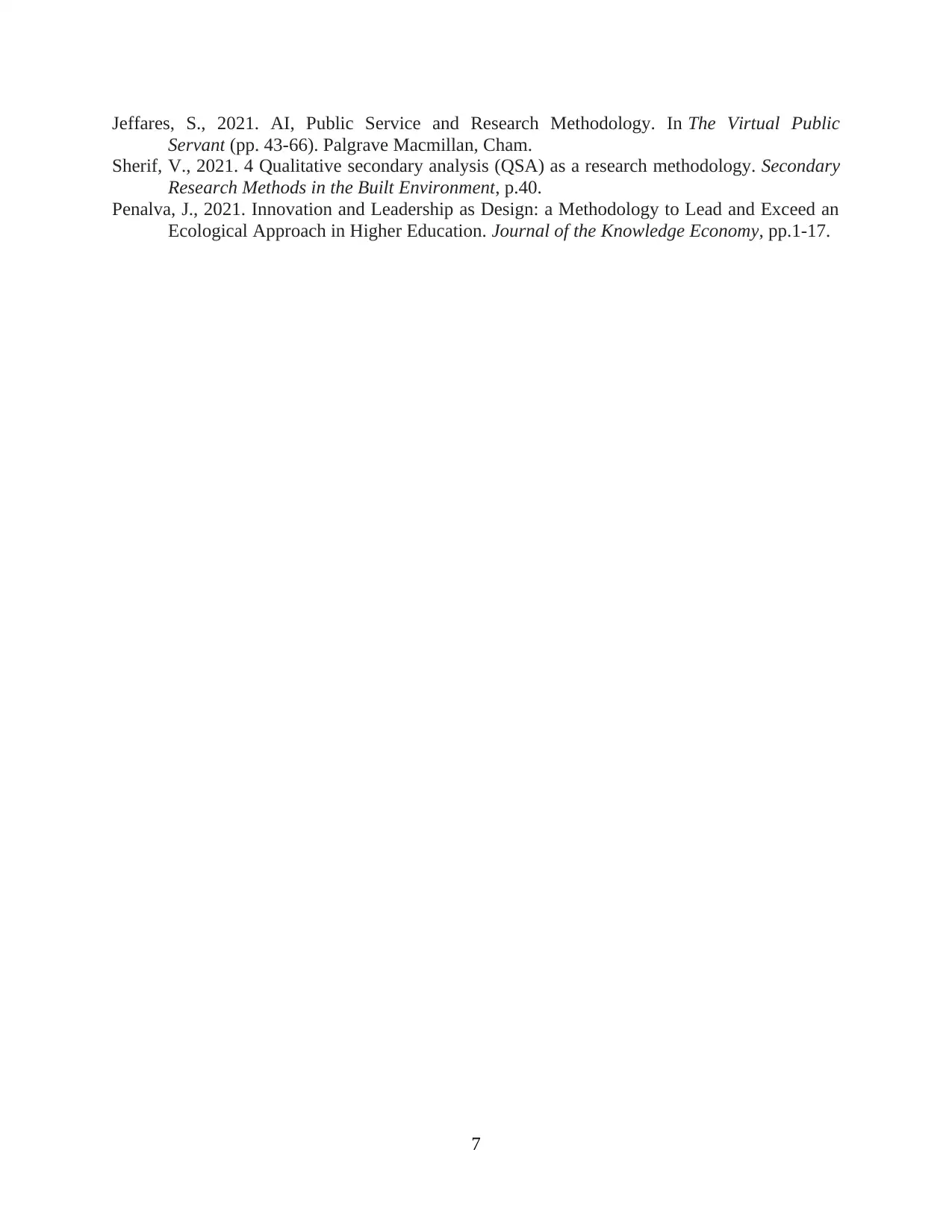
Jeffares, S., 2021. AI, Public Service and Research Methodology. In The Virtual Public
Servant (pp. 43-66). Palgrave Macmillan, Cham.
Sherif, V., 2021. 4 Qualitative secondary analysis (QSA) as a research methodology. Secondary
Research Methods in the Built Environment, p.40.
Penalva, J., 2021. Innovation and Leadership as Design: a Methodology to Lead and Exceed an
Ecological Approach in Higher Education. Journal of the Knowledge Economy, pp.1-17.
7
Servant (pp. 43-66). Palgrave Macmillan, Cham.
Sherif, V., 2021. 4 Qualitative secondary analysis (QSA) as a research methodology. Secondary
Research Methods in the Built Environment, p.40.
Penalva, J., 2021. Innovation and Leadership as Design: a Methodology to Lead and Exceed an
Ecological Approach in Higher Education. Journal of the Knowledge Economy, pp.1-17.
7
1 out of 10
Related Documents
Your All-in-One AI-Powered Toolkit for Academic Success.
+13062052269
info@desklib.com
Available 24*7 on WhatsApp / Email
![[object Object]](/_next/static/media/star-bottom.7253800d.svg)
Unlock your academic potential
Copyright © 2020–2025 A2Z Services. All Rights Reserved. Developed and managed by ZUCOL.





